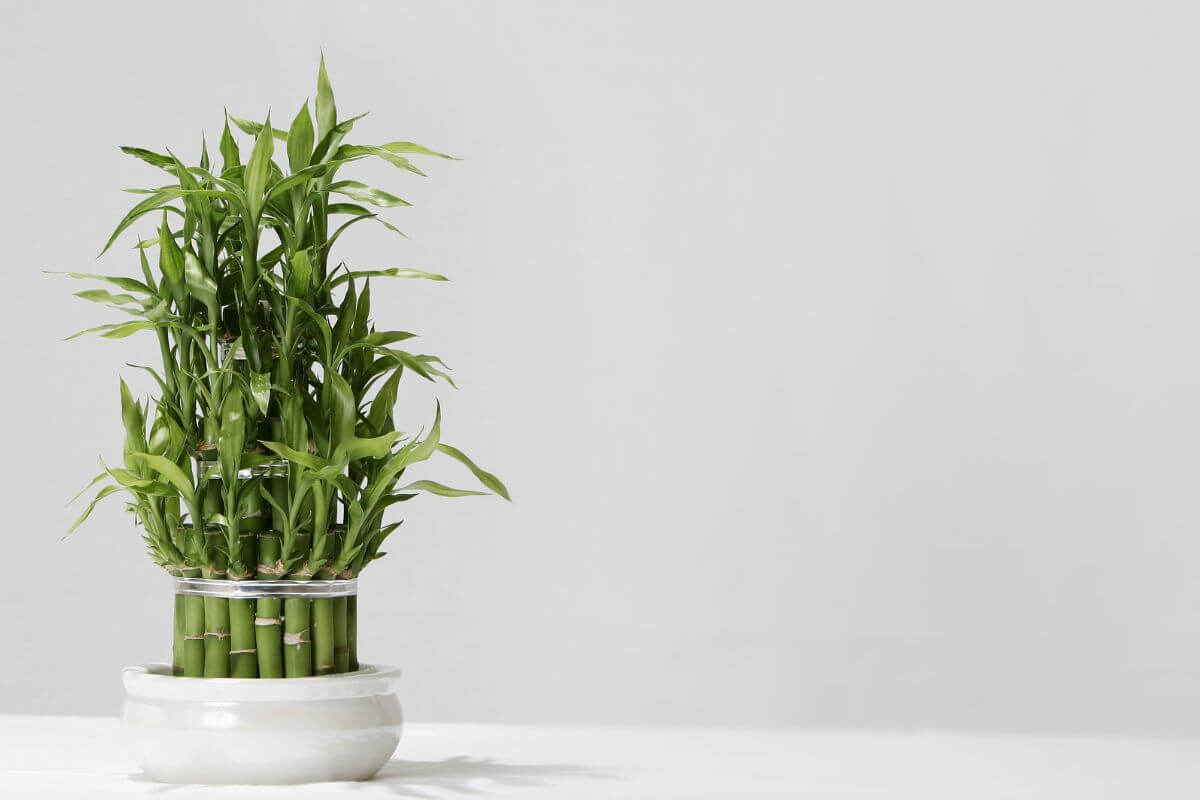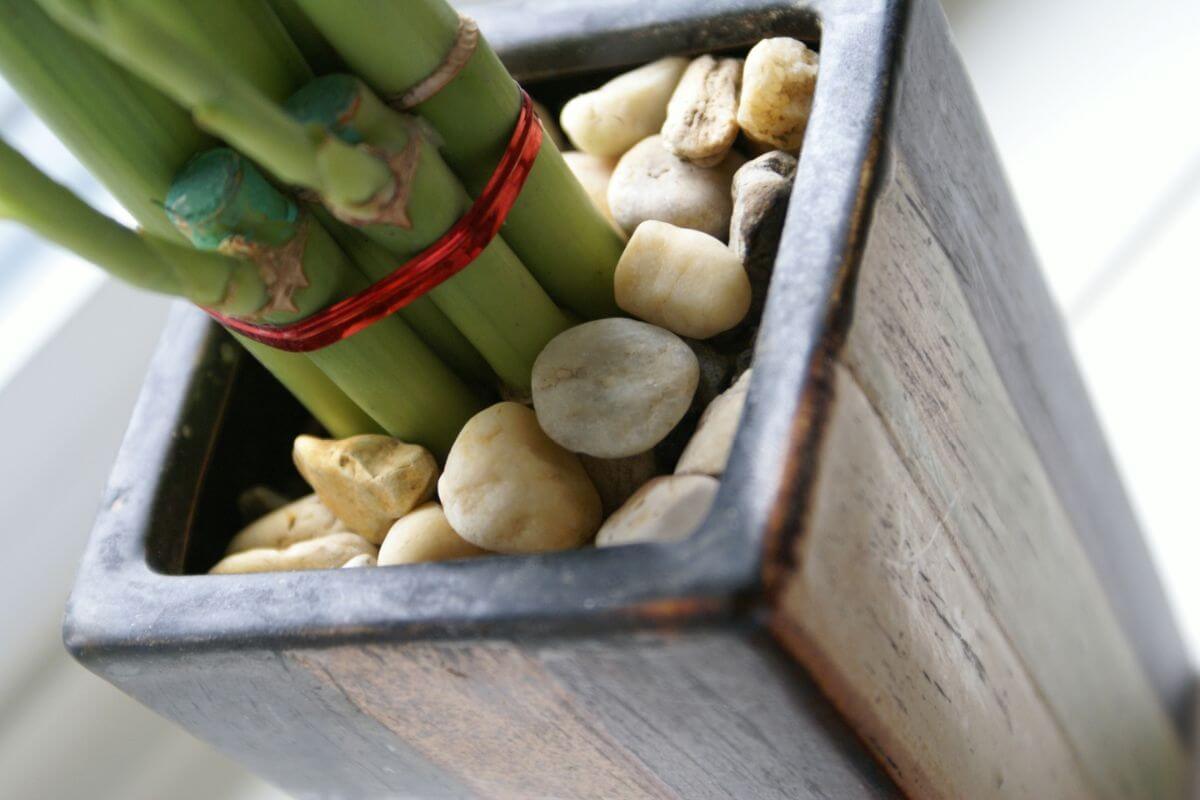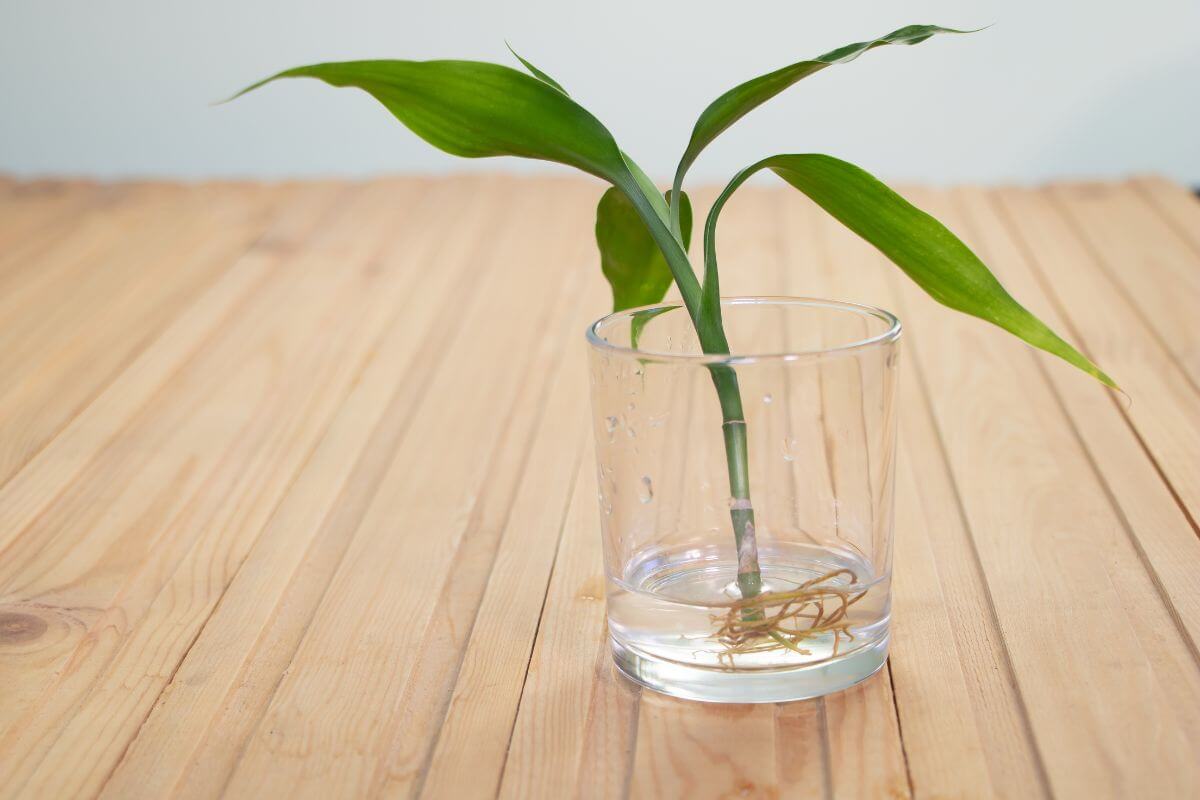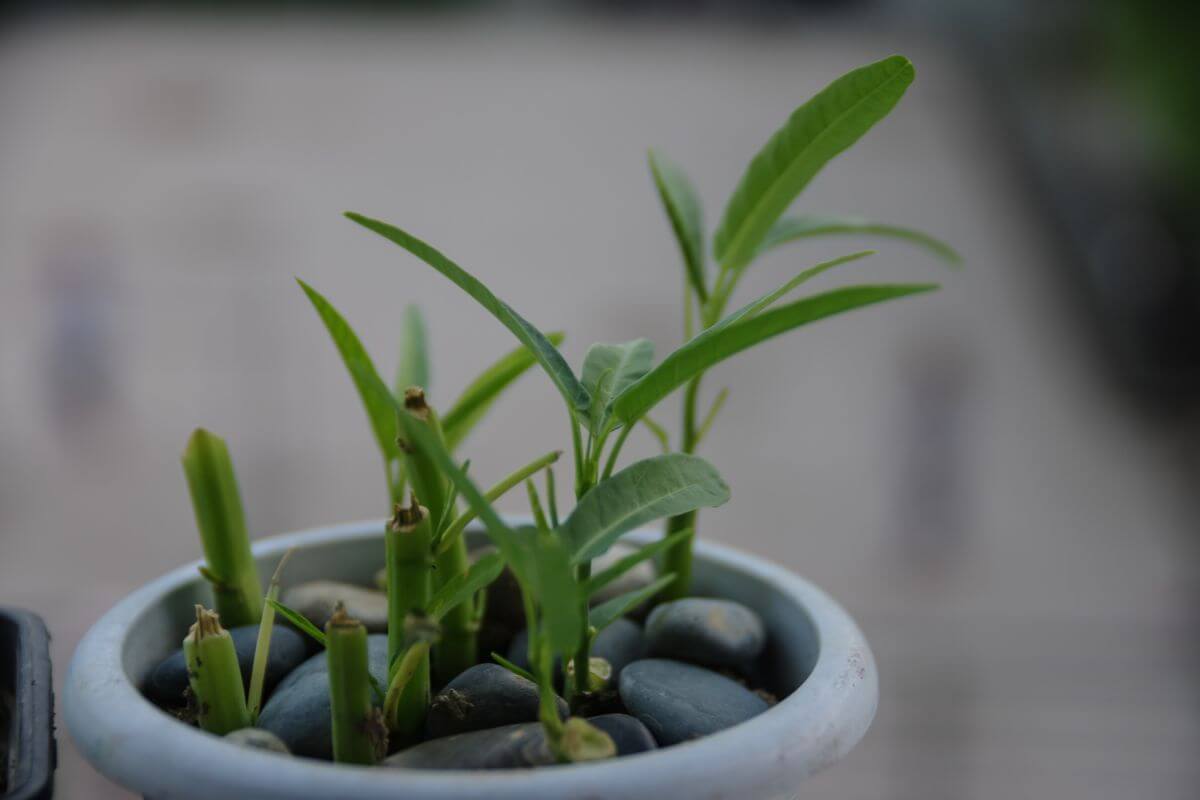Lucky Bamboo is everywhere nowadays, in homes, offices, and places of business. As the bearers of good luck, this delightful houseplant is said to be especially lucky when gifted to someone.
It also is known to be easy to care for, making it a wonderful houseplant for beginners and those who do not have a lot of time to dedicate to its care.
This care guide will help you learn how to care for the lucky bamboo.
Lucky Bamboo Overview

Botanically known as the Dracaena sanderiana, and a member of the Asparagaceae family, it is commonly known as Lucky Bamboo, Chinese Water Bamboo, Friendship Bamboo, or as the Ribbon Plant.
- Learn More about the Dracaena Varieties
Most people would be surprised to learn that the lucky bamboo originally called Africa home. Today, most come from China or Taiwan, where professional cultivators create lovely plant sculptures through curling, twisting, and braiding plant stalks into numerous shapes.
While the stems of this plant do resemble bamboo, it actually is not related to bamboo and is similar to a succulent.
These plants are generally not started by gardeners from seed, but are purchased. This perennial shrub is sold young, so you can enjoy the task of nurturing it to maturity.
When cultivated indoors, it can grow to heights of one to three feet tall and one to two feet wide.
Lucky Bamboo Plant Care
For a Lucky Bamboo plant to thrive it will require certain environmental conditions, including water, light, soil bed, temperature, and fertilizer. These will allow you to grow a healthy, thriving indoor plant, but it’s a survivor despite the level of care provided.
It is thought to bring good fortune to its owner and the number of stalks also has meaning.
- Three stalks indicate happiness and good health
- Eight stalks indicate prosperity and development
Soil for Lucky Bamboo

Lucky bamboo plant can be grown in soil or water.
Rich, well-draining potting soil is ideal for creating the soil bed for this household plant. Soil should remain constantly moist, but should not be waterlogged or soggy. You can mix two parts of potting soil with one part vermiculite, or peat moss.
If you grow your plant in water, it is important to add pebbles or stones to help provide anchorage and support to your plant. The lucky bamboo can be grown in a container of pebbles or in a jar or vase filled with at least one inch of water at all times.
Light for Lucky Bamboo
The lucky bamboo prefers dappled or filtered bright light, as if it were growing underneath a canopy of trees. Exposure to direct sunlight may scorch the foliage, so indirect light is best.
If you find the plant stretching upward or in a specific direction and is characterized by fading color, it probably needs more exposure to light. It can still thrive in low light conditions, however not in darkness.
Water and Humidity for Lucky Bamboo
This plant is particularly sensitive to chlorine and other chemical compounds found in municipal tap water. It is better to water it with distilled water.
You can use tap water, but your container of water should be left out for at least 24 hours to allow for the evaporation of chlorine.
If you place your lucky bamboo in water and notice red roots, this is indicative of a healthy plant. Water should be changed weekly.
The lucky bamboo thrives with average humidity levels, so it does not have any specific requirements.
Temperature for Lucky Bamboo
Lucky bamboo prefers a warmer climate that’s between 65° and 90° Fahrenheit. When you select a location in your home or office, avoid hot and cold drafts.
Avoid placing it anywhere near an air conditioning or heating vent, drafty window, hallway, or near a door.
Fertilizer for Lucky Bamboo
Natural fertilizers are best, such as compost or manure. If you do not have these readily available, one single monthly drop of a liquid fertilizer is sufficient for the lucky bamboo.
If you’re growing it in water, this can be reduced to bi-monthly. Liquid fertilizer should be diluted and weak. Specific fertilizers for this plant are available.
Lucky Bamboo Pruning and Repotting
Pruning or trimming is important to your lucky bamboo’s overall health. They tend to become top-heavy as they mature. If you purchased your plant with an intricate shape, it may tend to lose its form over time.
It is not wise to prune the plant’s main stalk. You can trim any offshoots with sterile scissors or gardening shears. Trim them to about one inch from the main stem.
After a while, you will notice that new stems will begin to emerge. This will help to have a bushier lucky bamboo. If you do not want new growth, just dip the cut end in paraffin to discourage any new growth at the cut.
It is important to select the right pot for your plant as this is a rapid grower. The type of lucky bamboo you acquire will also influence the selection of a pot.
Several species are considered runners, meaning their shoots can grow in any, and all directions. Other species are climbers and will grow straight upwards. It’s best to choose a container that has twice the diameter of the plant’s root ball.
When your plant outgrows its pot, you can trim the roots and replace the soil bed with a new soil mix. Choose a new container that is larger.
Propagating Lucky Bamboo

Lucky bamboo is easy to propagate. Take a healthy stem cutting that has at least one joint, but several would be better. Prune excess leaves and leave the node exposed. You can root this cutting bare or apply the rooting hormone, although this is not necessary.
Trimmings can be directly rooted by placing them in a jar of distilled water. Keep the water clean by changing it, as needed. Once roots have appeared, the plant can be transferred to a pot of pebbles or potting soil.
If you wish to root your cutting in soil, remember that at least one growth node should be planted beneath the level of the soil.
Shaping Lucky Bamboo
While lucky bamboo can be shaped into interesting forms, it is not shaped in a traditional manner such as the art of the Bonsai Tree which uses pruning and wiring.
The lucky bamboo is shaped by inspiring the bamboo stalks to turn naturally toward a light source. This means you will be rotating your plant to inspire it to grow in certain directions.
This type of rotation causes the plant to bend, twist, or curl. It will take time. You can position your lucky bamboo underneath a box with three sides.
The growth rate will need to be observed and you will need to rotate your plant regularly at a very slow pace. This is a test of patience, but your plant will reward you with intricate designs.
You can attempt to twist new soft shoots around the main stem to obtain a curling design. If you choose the more rapid method of manipulating new young stalks, you might use plant training wire to wrap around the stalks during twisting.
For straight stalks, you can use a totem pole or support to keep your stalks erect. Also, consider using ribbon or wire to hold multiple stalks together, however, do not tighten the ribbon or wire too much.
Lucky Bamboo Toxicity and Pets
This plant is considered to be low in poison severity for humans. It does contain saponins that can cause vomiting, anorexia, depression, hypersalivation, and dilated pupils in cats. If your cat has ingested lucky bamboo, contact your veterinarian immediately.
Lucky Bamboo Pests, Diseases, and Problems

The greatest danger to a lucky bamboo is usually posed by the water. If your city has high chlorine levels in the water supply, leaves will turn brown at the tips and lead to its death.
If the roots turn black, they should be trimmed and removed. Dead foliage should never be left in the water to rot as bacteria will develop.
Should you notice any algae growth when cultivating your lucky bamboo in water, just clean it out and replace it with clean water. If algae growth continues to be a problem, try using an opaque glass vase or container.
Yellowing leaves are an indication of too much sunlight or too much fertilizer. Interrupt fertilizing and move your plant to a position with more shade. Brown leaves indicate polluted water or air that is too dry.
Make sure the water is appropriate and try misting your plant every few days to improve humidity. Should the stems turn mushy and begin to rot, the plant should be disposed of. Any decayed stalks should be removed as they threaten the rest of the plant.
Common tropical houseplant pests can infest your lucky bamboo. You can either try an organic insecticide or attempt to remove the bugs manually.
Lucky Bamboo Care Final Thoughts
The lucky bamboo is a lovely and neglect-resistant plant that asks little of its owners. It makes an interesting conversation piece when positioned on a desk or table. It is also a lovely present as you are not only gifting a plant, but good fortune.
More houseplant care guides you may be interested in:
- Jade Plant Care and Grow Guide
- Kalanchoe Plant Care and Grow Guide
- Chinese Evergreen Care and Grow Guide
- Bamboo Palm Care and Grow Guide
Lucky Bamboo Care FAQs
Can you grow bamboo in water?
Yes! Lucky bamboos thrive in both soil and water. The best time to start growing them indoors is springtime. If you want to grow it in water, it helps if you add pebbles or rocks to anchor the plant. Lucky bamboo can be grown in containers of pebbles or jars or vases filled with at least one-inch of water at all times.
Does lucky bamboo really bring luck?
It depends on how you look at things. In many Asian cultures, it is believed to bring good luck, good health, peace, prosperity, happiness, and longevity. When you give lucky bamboo as a gift to someone else, the number of stalks you give sends a certain message. 3 stalks mean good health and happiness. 8 stalks mean prosperity and development.
Is it bad luck to buy your own bamboo plant?
No, buying your own lucky bamboo does not bring bad luck. It doesn’t matter whether the lucky bamboo was a gift or you purchased it yourself, it’ll bring good fortune to the home it’s in.
How long do bamboo plants live?
A lucky bamboo can live for about 15-20 years with proper care. However, some varieties have been known to live up to 100 years. The majority of lucky bamboo live 7 to 10 years due to the level of care. They need plenty of light, fresh water, and nutrients throughout their life cycle.
How many bamboo stalks are lucky?
A different number of lucky bamboo stalks mean different things. If you’re looking for good luck, 9 bamboo stalks is what you want. 21 stalks will bring you great wealth and lasting health
Why does a bamboo plant turn yellow?
When a bamboo plant turns yellow, this means that there’s too much direct sunlight or too much fertilizer. Try giving it some more shade if it’s getting too much direct light. If it’s too much fertilizer, cut back on it for a couple of weeks to see if it helps.
Where should I place lucky bamboo in my house?
According to Feng Shui, where to place the lucky bamboo depends on the energy flow of your home or office. The Southeast or East areas of the room that you want to place the lucky bamboo in. The Southeast position will attract wealth and money. The East position is to protect the family and occupants against illness and provide them with good health.
What if lucky bamboo dies?
If your lucky bamboo dies, you don’t have to worry about bad luck. They’re known to bring good luck, but they don’t do the opposite either. Unfortunately, dead lucky bamboo can’t be revived. But if it’s just brown or yellow leaves, you have a better chance to save them.



